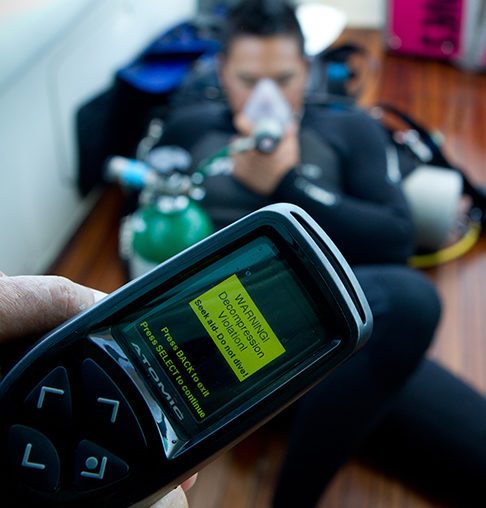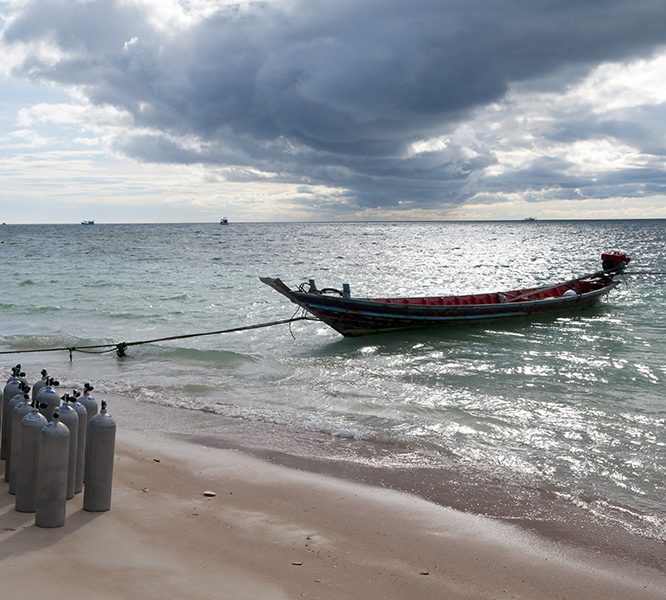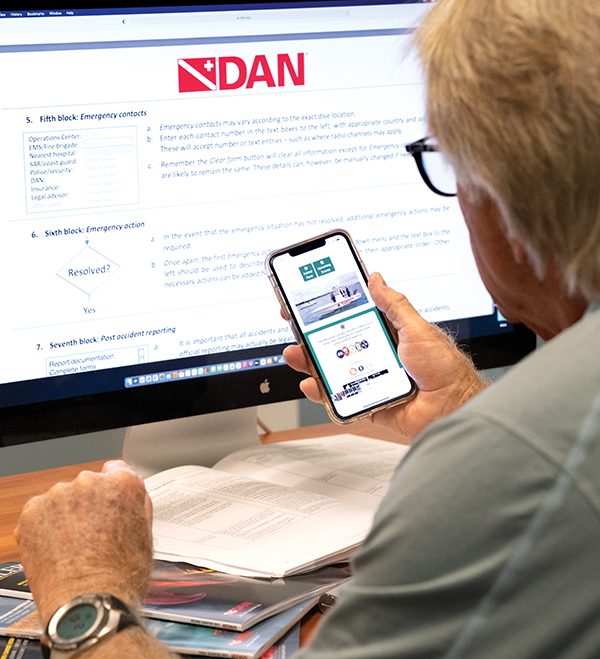EMERGENCY
ACTION PLANS:
WHEN THINGS
GO WRONG

SCUBA EXPERIENCES ARE NOT WITHOUT RISK, and accidents are always possible. But with the right plans in place, incidents can be managed, and harm can be limited. Emergency action plans (EAPs) are essential risk mitigation tools for dive operators and dive professionals to limit liability and ensure the safety of divers, staff, and the public.
Each aspect of a dive operation has its unique risks. Understanding what these risks are and how various accidents should be managed is a key element of safe operations. Whether in the dive center or at a dive site, different circumstances, activities, and locations will require different emergency action plans. Customizing your plans for each potential situation is crucial for ensuring customer and employee safety.
Assess Your Dive Center
Dive centers may have any or all of the following areas: retail shop, classroom, service workshop, gear rental storage area, and cylinder filling station. Each has its own unique list of emergencies that may include medical emergencies, pressurized equipment explosions, electrocution, and even aggressive behavior. Each requires its own action plan, emergency equipment, outside assistance services, and, most importantly, specific training to know how to react appropriately.
Consider sitting down with staff and working together to identify potential risks. From this list, start brainstorming possible plans based upon what resources are available and what is realistic to achieve.
Assess Your Dive SITES
You may use a pool or other confined-water location for training or use dive boats or other shore-based means to access your dive sites. Weather and sea conditions vary dramatically, as do remoteness, exposure to diving emergencies, and access to emergency assistance. These are all factors to consider when assessing risks and creating plans. Being aware of and understanding the accidents and incidents that may occur are essential aspects of your preparation for safe operations.
Assess Your VEHICLES
Several factors need to be considered when assessing vehicles used for transporting divers. Beyond licensing and equipment requirements, you are responsible for planning for and carrying out emergency procedures that are not always top of mind. In some cases, the emergency action plan is going to include steps that require careful planning, training, and equipment.
Vehicle road accidents, fires, death onboard your vessel, and in some areas even hijacking are emergencies we generally would prefer not to think about — but it is important to consider and develop plans for risks such as these.
Assess Your EMERGENCY
ACTION TRAINING–REGULARLY!
Compiling and implementing emergency action plans require very specific training to ensure that you will be able to respond appropriately during times of potential chaos and that assistance numbers and emergency equipment will help you manage. Keep your emergency plans at the forefront of your mind as a dive operator. This means you should not simply file your emergency action plan for when you might need it; rather, you should perform walk-throughs to review the effectiveness of the plan and then do realistic drills at least once a year to ensure you and your staff are able to execute all the necessary emergency actions effectively.



Scan here to create custom emergency action plans for all aspects of your operations.
DAN Customer Service
Mon–Fri, 8:30 a.m. – 5 p.m. ET
+1 (919) 684-2948
+1 (800) 446-2671
Fax: +1 (919) 490-6630
24/7 Emergency Hotline
In event of a dive accident or injury, call local EMS first, then call DAN.
24/7 Emergency Hotline:
+1 (919) 684-9111
(Collect calls accepted)
DAN must arrange transportation for covered emergency medical evacuation fees to be paid.
Medical Information Line
Get answers to your nonemergency health and diving questions.
Mon–Fri, 8:30 a.m. – 5 p.m. ET
+1 (919) 684-2948, Option 4
Online: Ask A Medic
(Allow 24-48 hours for a response.)